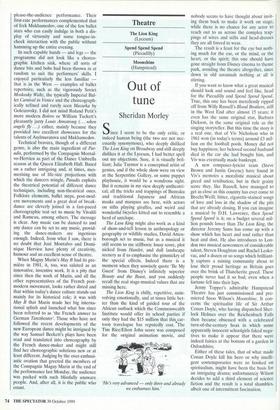Dance
Mukhamedov & Company (Sadler's Wells) Dance Umbrella (Queen Elizabeth Hall)
Talent spotting
Giannandrea Poesio
Iam always wary of performance titles that pair the name of a popular ballet star with words such as '& company' or 'and friend'. The few years I spent in the theatre taught me that both the friends and the company in question are often a bunch of second-rate wannabes whose sole function is to make the star look more splendid. And, regardless of the dancers' artistic merit, most '& company' performances are merely an empty and repetitive display of ballet acrobatics, aimed purely at pleasing those whose greatest fun in life is to count the ballerina's fouettem one by one.
When the curtain went up on the first night of Mukhamedov & Company at Sadler's Wells, I could not help frowning. To kick off with the theatricalisation of a daily ballet class, one of the most trite choreographic expedients I can think of, did not bode well. But, as soon as the more complex and pyrotechnic sequences replaced the exercises at the bar, the atmo- sphere changed dramatically and the entire show took off.
The refined technique and artistry of dancers such as Altynai Asylmuratova, Gillian Revie, Mara Galeazzi, Lilia Musarova, Natalia Ogneva, Johan Cobborg and Aidar Akhmetov, who are far from being the typical 'friends' described above, dispelled any risk of slipping into a cheap, please-the-audience performance. Their first-rate performances complemented that of Irek Mukhamedov, one of the few ballet stars who can easily indulge in both a dis- play of virtuosity and some tongue-in- cheek interaction with the public without hamming up the entire evening.
In such capable hands — and legs — the programme did not look like a choreo- graphic kitchen sink, where all sorts of dance bits and bobs had been thrown in at random to suit the performers' skills. I enjoyed particularly the less familiar that is in the West — examples of ballet repertoire, such as the vigorously Soviet Moskosky Waltz, the typically Imperial Bal- let Carnival in Venice and the choreograph- ically refined and rarely seen Mazurka by Goleizovsky. I did not mind Roland Petit's more modern Bolero or William Tuckett's pleasantly jazzy Louis Armstrong (. . . when angels fly . . .) either, mainly because they provided two excellent showcases for the talents of Asylmuratova and Mukhamedov.
Technical bravura, though of a different genre, is also the main ingredient of Par- adis, performed by the Compagnie Montal- vo-Hervieu as part of the Dance Umbrella season at the Queen Elizabeth Hall. Based on a rather intriguing and, at times, mes- merising use of life-size projections with which the dancers mingle, Paradis exploits the theatrical potential of different dance techniques, including non-theatrical ones. Folklore elements, ballet steps, post-mod- em movements and a great deal of break- dance are cleverly joined in a fast-paced choreographic text set to music by Vivaldi and Rameau, among others. The message is clear. Any music can be danced to and any dance can be set to any music, provid- ing the dance-makers are ingenious enough. Indeed, from what I saw, there is no doubt that Josd Montalvo and Domi- nique Hervieu have plenty of creativity, humour and an excellent sense of theatre.
When Maguy Marin's May B had its pre- miere in 1981, it, too, was saluted as an innovative, inventive work. It is a pity that since then the work of Marin, and all the other representatives of the French post- modern movement, looks rather dated and that within today's dance culture stands out mainly for its historical role; it was with May B that Marin made her big interna- tional splash and launched what has since been referred to as the French answer to German Tanztheater'. Those who have not followed the recent developments of the new European dance might be intrigued by the way Samuel Beckett's plays have been read and translated into choreography by the French dance-maker and might still find her choreographic solutions new or at least different. Judging by the over-enthusi- astic ovation that greeted the members of the Compagnie Maguy Marin at the end of the performance last Monday, the audience was packed with such blissfully unaware people. And, after all, it is the public who count.



























































































 Previous page
Previous page